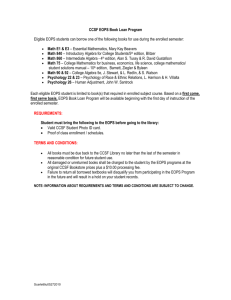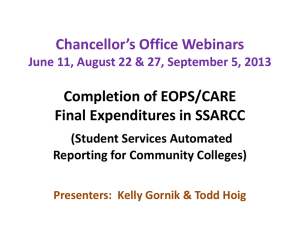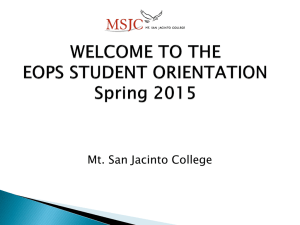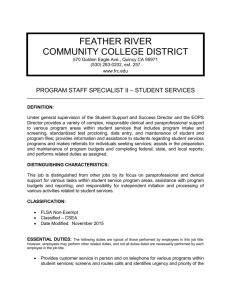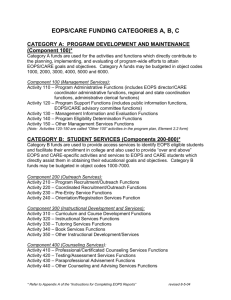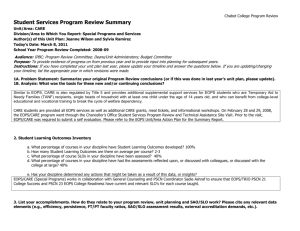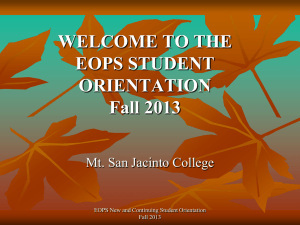EOPS and CARE Program Update
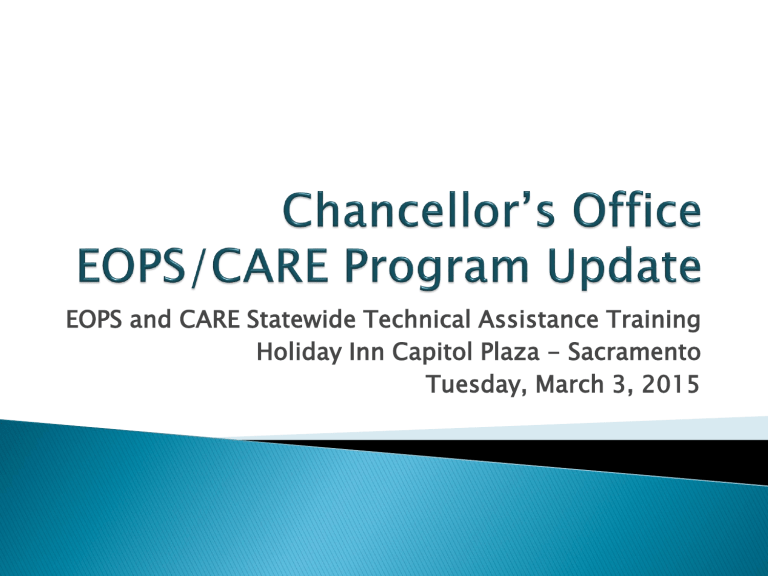
EOPS and CARE Statewide Technical Assistance Training
Holiday Inn Capitol Plaza - Sacramento
Tuesday, March 3, 2015
Presenter:
Kelly Gornik, EOPS/CARE Specialist kgornik@cccco.edu
and (916) 323-4281
Written By:
Cheryl Fong, Former State Coordinator of EOPS/CARE and happy retiree and Kelly Gornik
Today’s PowerPoint Wizard:
Cristina Mora, CalWORKs Liaison cmora@cccco.edu
and (916) 445-1643
Annual Audit Findings and Categorical
Budget Adjustments
New Staff: CCC Chancellor’s Office
Upcoming Events in 2015
2014-15 EOPS and CARE reallocated funds
New College in 2015-16: Clovis
Community College
Status of EOPS and CARE allocations funding formulas
EOPS Full-Time Director Requirement
District Match funds
Counting a Student As Served
EOPS-Funded Computer Equipment, Furniture,
& Travel Costs for Non-EOPS Staff to
Participate in EOPS Functions
Old EOPS-funded equipment and textbooks:
Disposal
EOPS Textbook services: What’s the difference between textbook lending library, book services, book rental program and book grants?
EOPS/CARE Over-and-Above Services
Examples of Activities not allowed with
EOPS/CARE funds
Priority registration for EOPS Students
EOPS and SSSP
California Dream Act
o AB 540 student eligibility for financial aid, scholarships, BOG fee waivers, and
EOPS/CARE
Limitations on EOPS Student Eligibility
o 70 degree-applicable units or six semesters o
Approved EOPS high unit majors
EOPS Counseling Contacts
o
When should three mandated EOPS counseling contacts occur?
o
Who provides mandated EOPS counseling contacts?
“Categorical Apportionment Adjustments Related to Annual Audit Findings” memorandum (October
2, 2014) posted systemwide by Chancellor’s
Office Fiscal Accountability Unit
Audit findings (beginning with 2012-13 audit year) that “reveal that some number of students served did not meet requirements for earned funding” will essentially result in adjustments
(i.e., reductions) to program funding in subsequent fiscal years.
Per October 2, 2014 memo from Assistant Vice
Chancellor Mario Rodriguez, audit adjustments from 2012-13 to be made in 2015-16
Apportionment Recalculation
Examples of 2012-13 audit findings that will result in audit adjustments:
EOPS
Unsigned Mutual Responsibility Contract
Missing Mutual Responsibility Contract
Missing EOPS student educational plan
Student had no documented contact with
EOPS or no active participation
Examples of 2012-13 audit findings that resulted in audit adjustments:
CARE
Student not eligible at the time of acceptance
Missing student educational plan
Missing application
Missing Mutual Responsibility Contract
CCCCO Student Services to determine level of audit adjustments for 2012-13 findings
Allocations to be adjusted in 2015-16 as a result of findings in 2012-13 audit year
Missing EOPS and/or CARE Advisory Committee
Meetings = Fiscal Adjustments (Penalties)
EOPS Advisory Committee = $500
CARE Advisory Committee = $250
EOPS/CARE Advisory Committee = $750
Additional information will be forthcoming.
Questions regarding audit process may be addressed to Fiscal Accountability staff:
◦ Tracy Britten tbritten@cccco.edu
(916) 323-6899
Christine Atalig catalig@cccco.edu
(916) 327-5772
Dr. Denise F. Noldon, Interim Vice
Chancellor for Student Services and Special
Programs Division – started January 20,
2015
EOPS/CARE Specialist (to fill behind Cheryl
Fong’s December 2014 retirement) - ?
Bryan Dickason, Student Financial
Assistance Programs – started January 20,
2015
Chancellor’s Office EOPS/CARE New
Directors/Coordinators Training – September
2015 in Sacramento – more information to come
CCCEOPS Association Annual Fall Conference
– October 20-22, 2015 in San Diego
CCCEOPSA Conference Website: http://ccceopsaconference.org/
To date, $40,669 in EOPS funds available to reallocate out
To date, $14,889 in CARE funds available to reallocate out
EOPS reallocated funds requests total
$806,500 ($651,000 for priority #1)
43 programs for priority #1
CARE reallocated funds requests total
$ 363,500
32 programs
Clovis Community College: Chancellor’s
Office Student Services and Special
Programs division will provide it with its own categorical allocations, including EOPS and CARE
Obtain input from campus EOPS/CARE programs statewide about CCCCO reinstating the EOPS and CARE allocations funding formulas starting in 2015-16 or 2016-17
Share simulations with campus EOPS/CARE programs to help explain formulas
Background:
Funding formulas used through 2008-09
In 2009-10, formulas were not used because
EOPS and CARE were cut by nearly 40%; each program cut 40% from what it received prior yr,
Since 2009-10, no change in CARE appropriation; formula not used since 2009-10
With exception of 2010-11, EOPS allocations formula not used since 2009-10, per agreement with statewide EOPS/CARE constituencies
In 2013-14, EOPS partially restored by $15 million; each program increased by 23%
EOPS Allocations Formula
Three elements :
Base Allocation: $50,000 to each college
Students Served: 90% of remaining funds allocated based on of # of students served statewide
College Effort: Remaining 10% allocated based on
“college effort” (defined as district contribution in excess of 15% minimum district contribution)
Student Cap:
Beginning in 1995-96, a funded student cap was place on # of students served/funded that was based on students served in 1993-94
Cap does not establish a ceiling or restrict # served
EOPS Allocations Formula
95% Guarantee :
Each fiscal year, colleges are guaranteed at least 95% of their prior year base allocations, unless the statewide EOPS appropriation is reduced more than 5% from the prior fiscal year
Colleges that return more than 5% of their allocation after the end of the fiscal year will have their next allocation reduced on a dollarfor-dollar basis by the amount that exceeds the allowable 5%; does not affect initial allocation
CARE Allocations Formula
1.
Base Allocation: $10,000 to each CARE program
2.
Students Served: Remaining funds are allocated based on # of CARE students served
CARE program receives funding based on formula or 95% of prior year initial allocation, whichever is more
CARE Allocations Formula (continued)
Plus COLA (cost-of-living) if provided in budget
Plus growth funds, if provided in budget and college CARE program meets minimum enrollment growth to be eligible for these funds
Minus fiscal penalties, if any
Minus other adjustments, if any
Title 5, section 56230: Each college shall employ a full-time director
Part-time director permitted only if college meets at least one of two allowed waiver criteria
1. “Small EOPS Program”: served less than
500 EOPS students and received less than
$500,000 EOPS allocation in prior fiscal year
2. Full-time assistant EOPS director or coordinator assigned 100% to EOPS/CARE: administers program in absence of director and represents the director as needed; if director is less than 50% EOPS/CARE, then assistant director must be certificated;
“ EOPS coordinator/counselor” meets criteria
Title 5, section 56210 “Comparable Level of
Services”: requires that there be a district match for EOPS & stipulates that match is determined by two figures from two formulas:
1.
Average district contribution reported in the final expenditures in the previous three fiscal years
2.
15% of the average EOPS allocation in the previous three fiscal years
Larger figure = district required match
Section 56210: requires CCCCO to use formulas every fiscal year
In 2009-10, CCCCO temporarily suspended using 56210 when EOPS and CARE were cut nearly 40%
September 16, 2009 CCCCO memo authorized CCCCO to cut district required match by 40% in 2009-10
“Remain at this (reduced) level through 2012-
13 or be adjusted proportionately by any decrease or increase in EOPS funds.”
2013-14 State Budget partially increased the
EOPS appropriation by $15 million
District required matches increased for each college by 23% in 2014-15 to match 23% increase to EOPS allocations in 2013-14
(CCCCO delayed the increase to district required match by one fiscal year)
The district required matches should remain at the 2014-15 levels in 2015-16
Director’s EOPS/CARE Time: Must be paid by district funds (and none of the director’s time can be paid with EOPS/CARE funds)
Other “over and above” EOPS expenses in object codes 1000-7000: In general, if EOPS funds are permitted to be used, then district funds can be used for those same types of expenses and counted as district match (not include direct aid category C expenses)
Student Success and Support Programs (SSSP)
Funds given to EOPS for “over and above”
EOPS services (i.e. assessments, orientation, counseling/advisement, student educational plan or follow-up services)
SSSP funds cannot be used to supplant EOPS or CARE funds (e.g. SSSP funds cannot be used for specific services/activities previously paid for by EOPS/CARE)
Student Equity Funds may be used as district match for EOPS, as long as student equity guidelines, rules and policies are met
NOTE: Supplanting of EOPS/CARE funds is strictly prohibited even if college exceeds its
EOPS district required match
Title 5, section 56204:
“For purposes of allocating EOPS funds, conducting audits and evaluations, an EOPS student served is a person for whom, at minimum, the EOPS program has documentation in the student’s file of an EOPS application, Education Plan, and Mutual
Responsibility Contract….”
In addition to the three required documents, an EOPS student must also:
Be provided with an EOPS service (including but not limited to orientation, counseling, priority registration, book services, etc.) and
Attend at least one class during the term in which s/he is being counted (class can be prior to first census)
Student attends classes but has no active participation in EOPS during the term
Student receives EOPS services prior to the first day of the term but drops out of college before the first day of class
Student is accepted into EOPS and subsequently disqualified during the verification and/or reevaluation of her application and therefore, ineligible for EOPS
September 16, 2009 “Administrative Relief” memorandum is still in effect for this
No prior written approval is currently needed
Do not exceed EOPS discretionary cost limit
EOPS discretionary cost limit: per Title 5, section
56295(a), EOPS-funded expenses in object codes
4000-6000 cannot exceed 10% of the total EOPS allocation or $50,000, whichever is less
September 16, 2009 “Administrative Relief” memorandum is still in effect for this
No prior written approval is currently needed
Do not exceed EOPS discretionary cost limit
EOPS discretionary cost limit: per Title 5, section 56295(a), EOPS-funded expenses in object codes 4000-6000 cannot exceed 10% of the total EOPS allocation or $50,000, whichever is less
September 16, 2009 “Administrative Relief” memorandum is still in effect for this
No prior written approval is currently needed
Do not exceed EOPS discretionary cost limit
EOPS discretionary cost limit: per Title 5, section
56295(a), EOPS-funded expenses in object codes
4000-6000 cannot exceed 10% of the total EOPS allocation or $50,000, whichever is less
Disposal of Old EOPS/CARE funded equipment with monetary value:
District may dispose per its rules for sale or disposal of old equipment; any money
generated goes back to EOPS/CARE; funds held in different account from state allocations
District may use outside of EOPS/CARE but remaining value must be assessed and district contribution increased in amount equal to residual value
Disposal Old EOPS/CARE funded equipment with monetary value (continued):
If within district policy, EOPS/CARE may sell equipment for fair market value and keep funds in separate account from allocations
Equipment shall not be given to another campus department because that move is the same as EOPS/CARE paying for non-
EOPS/CARE functions
Old EOPS/CARE funded equipment with no monetary value:
Should be disposed of by district per its policy for the surplus of old equipment
EOPS may donate the equipment to a library or another organization that is willing to accept old or obsolete equipment
Disposal of Old EOPS/CARE funded textbooks with monetary value:
District may dispose per its rules for sale or disposal of old books; any money generated goes back to EOPS/CARE; funds held in different account from state allocations
District may use outside of EOPS/CARE but remaining value must be assessed and district contribution increased in amount equal to residual value
Disposal of Old EOPS/CARE funded textbooks with no monetary value:
Should be disposed of by district per its policy for the surplus of old books
EOPS may donate books to a library or another organization that is willing to accept them
EOPS Textbook Lending Library
Textbooks are the property of the EOPS program and students are required to return textbooks to EOPS
Textbooks are required in classes in students’ approved educational plan
Object code 4000, category B – discretionary cost
Book Service Program
Non-cash assistance
May or may not have completed financial aid application process
EOPS must notify campus FA office in timely manner
For required textbooks/workbooks only in student’s approved educational plan
Textbooks belong to student
Okay to reimburse students for textbooks
Object code 7000, category B
EOPS Book Rental Program (EOPS pays for the rental fee of the college book rental program)
Non-cash assistance
Okay to reimburse students for rental fee
May or may not have completed financial aid process
EOPS must notify campus Financial Aid in a timely manner
For required textbooks/workbooks only
Textbooks are the property of the rental entity
Student is responsible for any damages
Object code 7000, category B
EOPS Book Grant
Student must have determined unmet need first because this is direct aid
For required textbooks, workbooks or other related materials such as CD for language classes or DVD of prepared classroom lectures
Textbooks belong to student
Object code 7000, category C
EOPS and CARE programs offer invaluable educational support, many of which are not cash-based financial assistance, but are services designed to assist low income, educationally disadvantaged students to succeed in their chosen educational goals
(certificate, associate degree and transfer) with EOPS/CARE over-and-above services, such as:
Orientation
Three mandated EOPS counseling contacts per semester with content prescribed by Title 5
1.
Education planning (interpreting assessment results, developing multi-term education plans, reviewing EOPS mutual responsibility contract)
2.
Progress monitoring/early alert and academic intervention (if needed)
3.
Reviewing academic success, planning class schedules, updating education plans, providing transfer assistance
First-tier priority registration
UC and CSU admission application fee waivers
If college EOPS/CARE program funds and resources are available, these services may also be offered:
Tutoring
Paraprofessional and peer advisement
Peer support groups
Classes, workshops, seminars and training to assist low income and single parent students
Assistance with transfer to four-year universities and colleges
Textbook lending library
Copying services
Laptop computer loan program
Computer lab
Typing/word processing services
End-of-year recognition programs
Emergency food closets (from non-EOPS/CARE resources)
Outreach activities to potential community college EOPS students
Educational grants
Child care (class hours and study time)
Emergency bus tickets/passes
Basic auto maintenance/repair services
On-campus meal services
School supplies
Uniforms
Graduation caps and gowns
Transcript fees
Application fees to public, private and out-of-state universities if fee waivers not offered
State vocational board examination and certification fees
Campus health fees
Campus parking permits
Fingerprinting fees for students enrolled in vocational majors (e.g., nursing, administration of justice, child development, etc.) and clearance for access to campus child development and child care centers)
EOPS emergency loan program
And more!
EOPS should serve as many students as it has funding and resources. There is no student cap!
EOPS and CARE students may be assisted by other programs for which they are eligible, but assistance given must not be duplicative or overawarded.
Students who receive CalWORKs cash aid should request that the county CalWORKs program provide
WTW ancillary services for textbooks, dependent care, transportation, school supplies and uniforms so college financial aid and EOPS/CARE grants/services are used as a last resource , not first.
If program funds are unavailable, EOPS/CARE is not required to award grants. EOPS/CARE can offer noncash supportive services only for eligible students.
Extended Leave: Including but not limited to sabbaticals, medical and administrative leaves
Why can’t EOPS/CARE pay? EOPS/CARE funds shall be used for employees who are actively employed in the program and providing “over and above” EOPS and CARE services
District pays for employee on extended leave
For EOPS/CARE-funded employees on extended leave, EOPS/CARE may pay for replacement person who will be actively working in
EOPS/CARE
Shared Governance (i.e. Academic and Classified
Senates), Union Activities, and Other Campus
Committees
The Chancellor’s Office recognizes that serving on the Academic and classified senate and other campus committees is a local decision.
For any campus activity, including the abovelisted ones, if the EOPS/CARE employee is representing and advocating for the EOPS/CARE programs, then EOPS/CARE funds are permitted to be used for that time.
First-tier priority enrollment is mandated only for these five groups of students:
EOPS (AB 595, Statutes of 2013)
DSPS (AB 595, Statutes of 2013)
CalWORKs (AB 86, Statutes of 2013)
Veterans/military (SB 813, Statutes of 2011)
Foster youth (AB 194, Statutes of 2011)
These five groups must be scheduled to enter first and at the same time for priority registration. No one group in first-tier may go ahead of another.
Students not meeting SSSP requirements do not have enrollment priority and will register after the third-tier.
Districts are not required to apply the registration priorities during summer sessions or intersessions.
The 100 degree-applicable unit limitation does not include units for non-degreeapplicable ESL or basic skills classes.
Districts may set the unit limit lower than 100 units, consider units earned from other colleges, and exempt students in high unit majors programs.
Since 1969
EOPS
= student success
EOPS is an essential partner in campus-wide efforts to fully implement SSSP core services.
As it had for nearly 30 years with matriculation services and must now do with SSSP, EOPS must clearly define its role and comply with
Title 5 over-and-above requirements to ensure that low income, educationally disadvantaged students continue to have access to college and receive the necessary supportive services to help them achieve their educational, career and personal goals successfully.
EOPS
is over, above and in addition to
Student Success!
Therefore:
EOPS orientation services must be over, above and in addition to the orientation offered by the college to all students.
EOPS counseling contacts must be over, above and in addition to the counseling offered by the college to all students.
EOPS education plans must be over, above and in addition to the plans developed by the college for all students.
Assembly Bill 130 (Cedillo)
On January 1, 2012, the California Dream Act of
2011 was enacted as a state law to provide financial aid eligibility for students who are exempt from paying nonresident tuition (i.e., AB 540 students) and meet these requirements:
Attended a California high school for three or more years (not three consecutive years)
Graduated from a California high school or attained the equivalent (i.e., earned a GED or passed the
California High School Proficiency Exam)
Are currently registered or enrolled at an accredited institution of higher education in California, including
UC, CSU and community colleges
If undocumented, have filed an affidavit with the college or university certifying intent to file an application to legalize their immigration status when eligible
In the community colleges, the confidential affidavit will be filed with the admissions and records office on campus.
The text of AB 130 (Cedillo) is available at http://leginfo.legislature.ca.gov/faces/billNavClient.xh
tml?bill_id=201120120AB130&search_keywords =
AB 130 allows California Dream Act (AB 540) students to apply for, and if selected, receive scholarships that are derived from non-state funds and administered by UC,
CSU and CCC, such as:
Scholarships awarded by private donors, alumni contributions, individual department efforts, professional associations, foundations, community organizations, charitable groups or donations from other entities.
$1,000 scholarships from the California Community Colleges
Scholarship Endowment – Bernard Osher Foundation, which awards students with the most financial need and have demonstrated academic success
Students should contact the college financial aid office for scholarship information and applications.
Assembly Bill 131 (Cedillo)
Since January 1, 2013, California Dream Act students may apply for, and participate in, statefunded financial aid and student aid programs for which they are eligible, such as:
Board of Governors Fee Waivers
Cal Grants
Chafee Grants
State student aid programs, such as:
EOPS
CARE
College CalWORKs
The text of AB 131 is available at the California
Legislative Information website http://leginfo.legislature.ca.gov/faces/billNavClient.xh
tml?bill_id=201120120AB131&search_keywords =
The California Student Aid Commission developed the
California Dream Act Application (or Dream App) that is available online at www.csac.ca.gov
Financial aid information and applications for students and families is available in English and Spanish at www.csac.ca.gov
and www.icanaffordcollege.com
websites.
Students with SSN will be directed to file a FAFSA, because they may apply for federal, state and other financial aid.
Undocumented students should submit the
Dream App , not the FAFSA, to determine their eligibility for state-funded financial aid
Students are not required, but should be strongly encouraged to file the Dream App , because statefunded grants and financial aid are available to help pay for their cost of education, if they meet income eligibility criteria.
Helpful information is also available in CSAC’s
California Dream Act FAQs at this website http://www.csac.ca.gov/pubs/forms/grnt_frm/cal_gr ant_dream_act_faqs.pdf
Students with questions about how the California
Dream Act may affect their immigration status are advised to consult with an immigration attorney.
Eligibility for Board of Governors Fee Waivers:
Dream Act/AB 540 students are eligible to apply for and, if they meet the income criteria, receive the
BOG fee waiver.
All community college students submit the same
BOG fee waiver application form
Campus admissions and records office must verify that students meet requirements for either California residency or California Dream Act/AB 540 status
If undocumented, students must file an affidavit with the college certifying their intent to file an application to legalize their immigration status when eligible. In the community colleges, the affidavit is filed with admissions and records office on campus.
Eligibility for EOPS:
Students are eligible for grants, services and work/study offered by EOPS, if they meet program requirements and EOPS funding/resources are available.
Dream Act students must submit confidential AB 540 affidavit to college admissions and records office
Apply for Board of Governors fee waiver and are strongly encouraged to submit Dream App to CSAC
Meet EOPS income eligibility requirements
Meet EOPS educational disadvantage requirements
Eligibility for CARE :
Students are eligible for grants and services offered by CARE, if they meet program requirements and
CARE funding/resources are available.
Students must meet EOPS income eligibility and educational disadvantage requirements (see EOPS eligibility information)
Meet CARE eligibility requirements
Currently receive CalWORKs cash aid either for themselves and/or dependent children to be eligible for CARE (at time of acceptance only, the student’s youngest child must be under age 14)
EOPS and CARE should process applications and determine eligibility for all new students in the same manner.
1.
Admissions and Records: verification of California residency or California Dream Act/AB 540 status
2.
Financial Aid: determination of student eligibility for
BOGFW-A and BOGFW-B; also BOGFW-C with zero
EFC (EOPS income eligibility requirement)
3.
EOPS: determination of EOPS eligibility based upon educational disadvantage as defined by Title 5
AB 130 and AB 131 do not limit the number of AB 540 students who can be accepted and participate in EOPS and
CARE. EOPS and CARE should serve as many programeligible students as the programs can accommodate.
EOPS and CARE should process applications in the order of when student applications are completed/submitted and when students have been determined eligible to be accepted into the programs.
AB 130 and AB 131 also do not restrict access or limit supportive services to California Dream Act students. EOPS and CARE over-and-above supportive services should be provided equitably to all program-eligible students as funding will accommodate.
70 Units or 6 Terms Limitation
Title 5, section 56226 states:
“A student who has met eligibility requirements and who participates without term-to-term interruption, shall continue to be eligible until the student: (a) has completed 70 degree applicable credit units…or has completed six semester terms or nine quarter terms of enrollment. Time spent by the student enrolled in remedial courses, including remedial level ESL courses, shall not be included when computing the requirements of this sub-section.
Section 56226 continues:
The EOPS director may waive this limitation only in cases where students are enrolled in programs which require more than 70 units, or which require prerequisites that would exceed the limitations.”
The EOPS director may also exit a student from EOPS, because the student: (b) “has failed to meet the terms, conditions, and follow-up provisions of the student Education Plan and/or the EOPS mutual responsibility contract.”
Title 5 section 56226(a) does not say completed 70 degree-applicable units or six semester terms “whichever comes first.”
Therefore, each college EOPS program may determine either 70 degree-applicable units or six consecutive primary semester terms as the limitation for EOPS student eligibility.
The policy must be: o approved by the EOPS advisory committee o written and posted as official campus EOPS policy and o applied in a consistent manner to all EOPS students
In accordance with section 56226, each college EOPS mutual responsibility contract should clearly cite the reasons (e.g., Title
5 section 56226(a) or (b) or other reason) for dismissing or exiting students from EOPS.
EOPS Students Enrolled in High Unit Majors
Students who are enrolled in approved high unit academic and vocational majors and in good academic standing may continue to be EOPSeligible until they complete their major requirements.
Continuing EOPS eligibility for students enrolled in high unit majors is allowable, but not required. The campus EOPS program has the option of electing to comply with the 70 degree-applicable unit limitation.
Currently, there are 56 academic and vocational majors that exceed the EOPS 70 degree-applicable unit limitation and are approved as high unit majors by the Chancellor’s Office.
TOP codes of approved high unit academic and vocational majors can be found on the EOPS webpage http://extranet.cccco.edu/Divisions/StudentService s/EOPS/MISDataReporting.aspx
Check the TOP codes list for approved majors.
Most approved high unit majors fall within these broad categories:
mathematics, science and engineering
information technology and computer sciences
business administration / business management
allied health occupations
nursing
liberal arts (teaching)
cosmetology and barbering
nutrition, foods and culinary arts.
If a program TOP code does not appear on the approved list, contact the Chancellor’s Office to review whether the program qualifies as a high unit major for EOPS.
Must the EOPS orientation and each of the three mandated EOPS counseling contacts take place during the academic term?
The Chancellor’s Office will permit the orientation and the first mandated EOPS counseling contact to occur within a reasonable time prior to the first day of the academic term in which a new student is accepted by EOPS.
The second mandated EOPS counseling contact must occur at an appropriate interval during the academic term to allow an EOPS counselor to offer timely advice, assistance and intervention, if needed, to address a student’s academic performance.
The third mandated EOPS counseling contact should occur prior to the end of the academic term or, if needed, soon after the last day of the term. (Reference: EOPS/CARE FAQ #E-38)
Who provides the mandated EOPS counseling contacts?
Certificated EOPS counselors who fulfill the minimum qualifications delineated in Title 5, section 56264 must provide the mandated
EOPS counseling contacts.
Is it possible for an academic advisor, paraprofessional or graduate student/counseling intern to provide the mandated EOPS counseling services?
Non-certificated academic advisors or paraprofessionals may offer academic advisement to EOPS/CARE students and assist
EOPS counselors, but only under the direct supervision of EOPS certificated counselors.
Pages 34-35 of the “EOPS Implementing
Guidelines” describe the role of peer advisors and paraprofessionals:
“Peer advisors and paraprofessionals may provide follow-up contacts and preliminary progress checks to eligible EOPS students along with informal advising.”
For example, a graduate student or intern may assist an
EOPS counselor in monitoring academic progress and may suggest appropriate intervention strategies, but the EOPS director or EOPS counselor is required to review the intern’s work and officially approve the intervention recommendations.
The supervision of the graduate student or intern’s work is especially important, because s/he is fulfilling a requirement for completion of the Master’s program and has not fulfilled the minimum qualifications for
EOPS counselor.
(Reference: EOPS/CARE FAQ #S-4)
